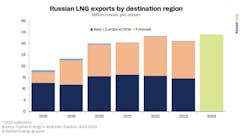Doris Leblond
OGJ Correspondent
PARIS, Dec. 3 -- This year has seen the worst performance of the international natural gas market in 40 years, with gas consumption not expected to exceed its 2008 high before 2014, said Armelle Lecarpentier, chief economist for Paris-based gas association Cedigaz.
Gas demand should fall by 4.2-5.5% this year and not grow beyond 1-1.5% in 2010 and not above 2%/year through 2012, said Lecarpentier at a recent press conference. She estimated gas production will be down 4.8% this year but will increase by 1.8-2.4% in 2010, driven by LNG projects in Asia and the Middle East. She sees a gas bubble developing that will last through 2015 and possibly into 2016.
By contrast, 2008 production increased 3.7% to 3.854 trillion cu m, with marketed production up 4.2% to more than 3.065 trillion cu m—the strongest growth in absolute terms since 1984.
Gas demand
Gas demand contracted this year, with large regional variations. The biggest declines are expected in Russia, with a 9% drop, and in other Commonwealth of Independent States (CIS) countries, down 17%, as well as an overall European decline of 8.5%. Gas consumption is anticipated to be down 23.5% in Brazil, 8.3% in Japan, 13.5% in South Korea, and 18.5% in Taiwan.
A slight 1% increase is expected in developing countries.
Cedigaz said gas prices should be competitive, averaging $6-6.50/MMbtu and boosting consumption in the Organization for Economic Cooperation and Development countries in 2010, albeit limited to less than 1%/year because of a sluggish economic upturn and increased competition from coal for base power generation in North America and Asia.
Even in northern Europe, where gas has strong growth prospects in the electric power generation, a number of factors limit gas expansion, including low penalties for carbon emissions, high level of coal storage in some countries, and environmental pressures to shut down coal-powered stations in the UK by 2015.
Gas supply
The decline in gas production in 2009 varied from one region to another, with the largest decrease likely in the CIS, where the deficit could be as much as 100 billion cu m (bcm). Production likely will be down 30 bcm in Europe and 16 bcm in Africa.
Production could increase 1.8-2.4% next year with firmer demand in Europe and the CIS, and especially through development of main gas projects in the Middle East and Africa.
Cediaz noted offshore production should gradually account for more of the world's total supply in coming years, particularly after 2015 when it could be 35% of global production, up from 27% currently.
Although no figures are available for 2009, Cedigaz reported out 11.4% of total gas production in 2008 was reinjected in oil fields, while flaring increased 4.6% to 134 bcm.
While international gas trade (including intra-CIS trade) increased 4.2% to 970.5 bcm in 2008, international trade in 2009 gasline trade suffer by the sharp drop in consumption in both the CIS and Europe, which together account for 70% of international gas line trade. Cedigaz expects a drop in gasline traded volumes of 10-15% over this year.
Besides a 60 bcm trade contraction among CIS countries, gasline trade with Europe's main suppliers—Algeria, Russia, the Netherlands—was strongly reduced this year as was trade between Canada and the US, Bolivia and Brazil, and Mynmar and Thailand.
Excess supply, on the other hand, gave LNG a competitive edge in the Atlantic Basin. There imports are estimated to have increased 10-15 bcm in 2009, compensating for the strong contraction of imports by Japan, South Korea, and Taiwan, which were down by 8.2%, 13.9%, and 12.5% from 2008, respectively.
Cedigaz anticipates 57 bcm of additional liquefaction capacity will come on stream by 2013, as well as 260 bcm regasification capacity, greatly exceeding the expected growth of global gas demand. With more than 100 bcm of new supply coming into the market over the last 2 years, combined with the strong contraction in demand, the current gas bubble could extend into 2016, the analysts reported.
As a result, Lecarpentier said, gas storage seems more than ever an indispensable tool to reestablish a market balance. By October, 638 underground storage sites were listed worldwide marketing storage capacity of 328.9 bcm, amounting to 10.7% of global annual gas consumption.
Cedigaz also recorded 199 storage projects with a total 115 bcm of additional paid capacity, including 80 bcm available by 2015.
Lecarpentier said spot prices remained on average 50% lower than gas prices indexed to oil prices or oil products during October 2008-October 2009, raising questions about the fundamentals of gas prices hitched to oil in Europe's and Asia's long-term contracts.

